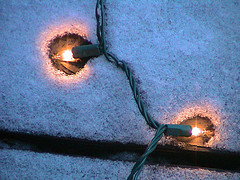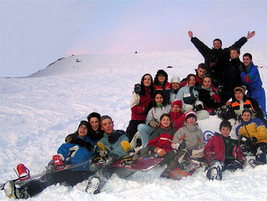|
Happy Holidays to all of the wonderful friends, supporters and clients of Raab Counseling & Consulting Services! May you experience peace and joy during this 2013 holiday season! Bethany Raab is a Licensed Clinical Social Worker in Denver, Colorado.
1) Go ice skating. 2) Write a letter to a friend or family member who lives far away. 3) Make a Christmas Carol music video. 4) Create place cards or other decorations for your family’s holiday celebration. 5) Bake cookies with friends. 6) Help a younger sibling write a letter to Santa. 7) Go sledding (or snowboarding or skiing!) 8) Have a holiday movie marathon. 9) Learn how to make a traditional family dish. 10) Wrap your bedroom door in paper or foil so it looks like a present. 11) Drink hot chocolate while reading a good book. 12) Turn off all lights except the Christmas tree lights. Relax in the quiet room or listen to music. 13) Volunteer time at a local charity. 14) Learn how other cultures and religions celebrate important holidays. 15) Bundle up and go for a walk to admire holiday lights in your neighborhood. Here are some links to websites that inspired this list and for more ideas! Parenting Teens: 50 Fun Holiday Activities Your Teen Will Love Parenting Teens: 101 Fun Things for Teens to Do This Winter Parent Map: 15 Meaningful Holiday Traditions and Fun Family Activities Here are some fun ideas for parents, too! Real Simple: 50 Fun Winter Activities Image from Flickr. Some rights reserved by katushya Bethany Raab is a Licensed Clinical Social Worker in Denver, Colorado.
 Hosting holiday meals, cookie baking, cleaning, decorating, traveling, hosting out-of-town guests, entertaining children who are out of school, holiday gift shopping, parties, and religious celebrations. Did I cause you to feel anxious just thinking about everything that the holiday season entails? This list is just a small example of what many people have planned for the next month. In a re-post from my 2012 holiday blog, here are some tips on managing your to-do list and having a little fun in the process! 1) Take a break. You are not obligated to attend every holiday party or community activity to which you receive an invitation. Rest and quiet time at home will help you be more flexible in stressful situations. 2) Have an ally. Talk with your partner, a close friend or trusted family member about how you are doing and any concerns you may have regarding schedules, difficult relationships or troubling behaviors by your children. Using your support network will help you manage difficult situations more easily than trying to do it on your own. Provide support to your children and teens during this busy time of year. Be sure to carve out quiet time with them during the holiday season. 3) Stick with the household rules. Children and teens should continue to complete their responsibilities and get to bed at a decent time, even if they are out of school. Keeping a schedule will help keep order during a traditionally busy time of year. This will also help decrease difficulties in returning to a normal routine after the holidays. And, yes, it is alright to give consequences to children and teens for not meeting their expectations during the holidays! 4) Be generous and express gratitude. The old statement "it's the thought that counts" is really true! It is not necessary to go into debt to satisfy your child or teen's holiday wish list. Teach your children about generosity by volunteering or buying gifts for underprivileged children. This will help them be more appreciative of the gifts they do receive. Writing thank you notes with your children and teens will help foster feelings of gratitude. Read more here about the benefits of gratitude in teens! 5) Create or continue meaningful traditions. Bake cookies, go ice skating, decorate the family tree and watch holiday movies. These traditions are what children and teenagers will remember and treasure as they grow older. Most importantly: take care of yourself so you can enjoy the joyous celebrations to come! Click here to read the original post. Image from Flickr. Some rights reserved by tonystl. Bethany Jones Raab is a Licensed Clinical Social Worker in Denver, Colorado.
 Fall and winter months bring familiar images of holiday parties, hot chocolate and, in Colorado, skiing and other winter sports. The cooler months bring excitement for many, while others have a different experience. Some people notice increased sadness, low energy levels, weight gain, a tendency to oversleep, irritability and a general "blah" feeling beginning in the fall and often lasting through the winter. These and other symptoms of the "winter blues" affect approximately 14% of Americans according to the National Center for Biotechnology Information. However, 6% of Americans experience a more marked set of symptoms known as Seasonal Affective Disorder, often referred to as SAD. Both the "winter blues" and SAD are frequently linked to a decrease in exposure to light during the fall and winter months. According to the Mayo Clinic, the actual causes of SAD are largely unknown. The good news is that SAD is a treatable condition. The Mayo Clinic recommends several types of treatment for SAD including light therapy and medication, both of which should be discussed with your doctor. Psychotherapy is also recommended as an effective form of treatment. Click here to learn more from the Mayo Clinic. Now for some more good news! A variety of alternative treatments for SAD can be utilized at home on their own or combined with a plan you discuss with your doctor. Here are a few ideas:
If you are feeling the effects of SAD as winter approaches, rest assured that you are not alone! Give some of these suggestions a try today. Finally, don't hesitate to speak with your doctor if you feel as though you need help managing symptoms of Seasonal Affective Disorder. Bethany Jones Raab is a Licensed Clinical Social Worker in Denver, Colorado.
|
Welcome!
Every blog post you see on this page is written especially for teens and their parents! Like it? Pin it!
Follow me!
Categories
All
|


 RSS Feed
RSS Feed